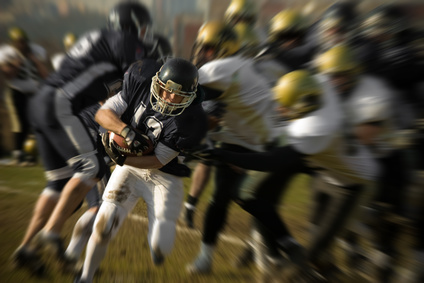2017/08/31

Aggressive games, such as American football, often cause players to get hurt on the field. People enjoy the aggression exhibited by players but they hardly realise how damaging it is for the players. While broken bones and ligaments can be treated, head injuries are another matter. They cannot be diagnosed easily. What players do not realise is that repeated head concussions lead to serious consequences for the long term.
Players of US football are known to suffer brain concussions, the highest among all sports. A high number of retired National Football League (NFL) players show symptoms related to brain injuries. The number of repeated concussions among American players is estimated to be 1.6 to 3.8 million every year. The annual costs associated with these are estimated at more than $76.5 billion [1-3].
Brain damage cannot be assessed in living patients. But now scientific studies are showing that repeated head concussions are the cause of long term cognitive damage among players. A brain bank was established in 2008, which houses the brains of former players. An analysis was conducted on the brains of the deceased players. The researchers found a high level of accumulated tau clumps in the brains. These clumps were found to be severe in 95 of the 110 brains of former players. A further study of 202 brains showed that 87% of them had chronic traumatic encephalopathy (CTE), which causes various cognition and behavioral problems [4,5].
Neuroimaging of the brains showed that 110 of the 111 deceased NFL players had CTE. The disease was also found in high school and college players to the extent of 21 and 90 percent respectively [4]. These findings showed the long term effects of brain injuries while playing – the incidence of the disease was directly correlated with the length of time that one played the game. However, concussions, or mild traumatic brain injuries, have so far have not been taken lightly and were found to lead to long-term health problems [6-8]. Depression is a common symptom that is found in former players [9]. Other symptoms such as cognitive problems and memory loss have also been reported.
CTE was first found among boxers. In 2005, it was first found in a former NFL player. There is no way to diagnose the disease in living patients and can be found only by doing an autopsy of the brain [10]. While only presumptive diagnosis of CTE can currently be done, new methods are being tried. A study has shown that a method called [F-18] FDDNP-PET helps in the diagnosis of CTE in living patients [11].
As a result of these findings, over 4500 former NFL players suffering from long-term effects of concussion filed a lawsuit against the NFL that it had not informed them about the dangers of repeated concussions. The NFL settled the lawsuit and agreed to pay $765 million. More important, rules were changed to make the game safer [12].
These findings shed light on sport related head injuries. There is an urgent need to educate both the players and the viewing public about the dangerous effects of head injuries in aggressive sports [13].